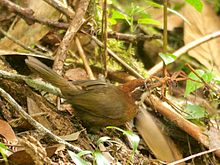| White-throated oxylabes | |
|---|---|

| |
| Conservation status | |
 Least Concern (IUCN 3.1) | |
| Scientific classification | |
| Domain: | Eukaryota |
| Kingdom: | Animalia |
| Phylum: | Chordata |
| Class: | Aves |
| Order: | Passeriformes |
| Family: | Bernieridae |
| Genus: | Oxylabes Sharpe, 1870 |
| Species: | O. madagascariensis |
| Binomial name | |
| Oxylabes madagascariensis (Gmelin, JF, 1789) | |
| Synonyms | |
|
Hypositta perdita | |
The white-throated oxylabes (Oxylabes madagascariensis) is a species of passerine bird that is endemic to Madagascar. It is the only species placed in the genus Oxylabes. Formerly considered as a member of the Old World warbler family Sylviidae, it has been moved to the family Bernieridae — the Malagasy warblers. Its natural habitat is subtropical or tropical moist lowland forests.
Taxonomy
In 1760 the French zoologist Mathurin Jacques Brisson included a description and an illustration of the white-throated oxylabes in the third volume of his Ornithologie based on a specimen collected on the island of Madagascar. He used the French name Le rossignol de Madagascar and the Latin name Luscinia madagascariensis. Although Brisson coined Latin names, these do not conform to the binomial system and are not recognised by the International Commission on Zoological Nomenclature. When in 1789 the German naturalist Johann Friedrich Gmelin revised and expanded Carl Linnaeus's Systema Naturae he included the white-throated oxylabes based on Brisson's description. He placed it with the wagtails in the genus Motacilla and coined the binomial name Motacilla madagascariensis. The white-throated oxylabes is now the only species placed in the genus Oxylabes that was introduced in 1870 by the English ornithologist Richard Bowdler Sharpe. The genus name is from Ancient Greek oxulabēs meaning "quick at seizing". The species is monotypic: no subspecies are recognised.
In 2013, genetic studies determined that the Bluntschli's vanga (also known as short-toed nuthatch-vanga), a species described in 1996 from two specimens collected in 1931, was actually this species. The specimens were both juveniles in a poorly known brown plumage.
Description
The white-throated oxylabes is a large warbler 17–18 cm (6.7–7.1 in) in length. It has short wings, long legs and a long stout bill. The upperparts are dark olive-brown with a rufous top and side of head. It has a narrow white supercilium and a white chin and throat. The underparts are dark brown. The sexes are alike.
References
- ^ BirdLife International (2016). "Oxylabes madagascariensis". IUCN Red List of Threatened Species. 2016: e.T22716763A94509959. doi:10.2305/IUCN.UK.2016-3.RLTS.T22716763A94509959.en. Retrieved 12 November 2021.
- Cibois, Alice; Slikas, Beth; Schulenberg, Thomas S.; Pasquet, Eric (2001). "An endemic radiation of Malagasy songbirds is revealed by mitochondrial DNA sequence data". Evolution. 55 (6): 1198–1206. doi:10.1554/0014-3820(2001)055[1198:AEROMS]2.0.CO;2. PMID 11475055.
- Brisson, Mathurin Jacques (1760). Ornithologie, ou, Méthode Contenant la Division des Oiseaux en Ordres, Sections, Genres, Especes & leurs Variétés (in French and Latin). Vol. 3. Paris: Jean-Baptiste Bauche. pp. 401–402, Plate 22 Fig. 1. The two stars (**) at the start of the section indicates that Brisson based his description on the examination of a specimen.
- Allen, J.A. (1910). "Collation of Brisson's genera of birds with those of Linnaeus". Bulletin of the American Museum of Natural History. 28: 317–335. hdl:2246/678.
- Gmelin, Johann Friedrich (1789). Systema naturae per regna tria naturae : secundum classes, ordines, genera, species, cum characteribus, differentiis, synonymis, locis (in Latin). Vol. 1, Part 2 (13th ed.). Lipsiae : Georg. Emanuel. Beer. p. 952.
- Sharpe, R. Bowdler (1870). "Contributions to the ornithology of Madagascar". Proceedings of the Zoological Society of London. 1870: 384–401 .
- ^ Gill, Frank; Donsker, David; Rasmussen, Pamela, eds. (January 2023). "Grassbirds, Donacobius, tetrakas, cisticolas, allies". IOC World Bird List Version 13.1. International Ornithologists' Union. Retrieved 23 May 2023.
- Jobling, James A. (2010). The Helm Dictionary of Scientific Bird Names. London: Christopher Helm. p. 387. ISBN 978-1-4081-2501-4.
- Fjeldså, Jon; Mayr, Gerald; Jønsson, Knud A.; Irestedt, Martin (2013). "On the true identity of Bluntschli's Vanga Hypositta perdita Peters, 1996, a presumed extinct species of Vangidae" (PDF). Bull. B.O.C. 133 (1): 72–75. Retrieved 12 August 2016.
- Bairlein, F. (2006). "Family Sylviidae (Old World Warblers)". In del Hoyo, J.; Elliott, A.; Sargatal, J. (eds.). Handbook of the Birds of the World. Vol. 11: Old Word flycatchers to Old World Warblers. Barcelona, Spain: Lynx Edicions. pp. 492–712 . ISBN 978-84-96553-06-4.
| Taxon identifiers | |
|---|---|
| Oxylabes madagascariensis |
|
This Sylvioidea-related article is a stub. You can help Misplaced Pages by expanding it. |